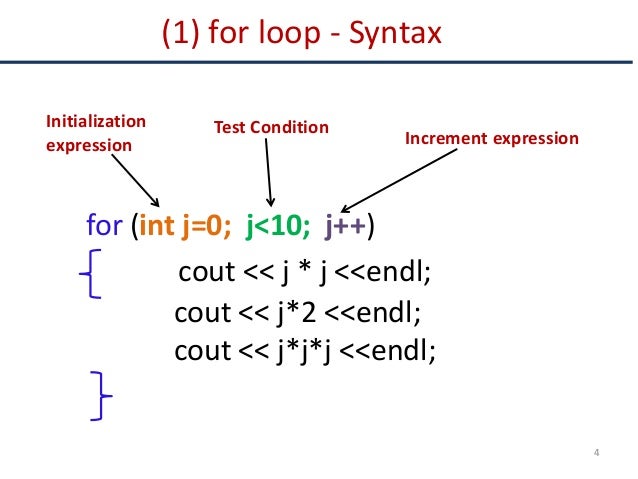For Loop Syntax In Dev C++
- C Programming Tutorial
- C Programming useful Resources
In C it is not possible to pass a complete block of memory by value as a parameter to (for example) a function. It is allowed to pass the arrays address to (for example) a function. Take a look at the following example.
- Instead of declaring and initializing a loop counter variable, you declare a variable that is the same type as the base type of the array, followed by a colon, which is then followed by the array name. In the loop body, you can use the loop variable you created rather than using an indexed array element.
- C goto Statement In this article, you'll learn about goto statment, how it works and why should it be avoided. In C programming, goto statement is used for altering the normal sequence of program execution by transferring control to some other part of the program.
- C for loop Syntax. The init step is executed first, and only once. This step allows you to declare and initialize any loop control variables. Flow Diagram.
- Dev-C Dev-C is a free IDE for Windows that uses either MinGW or TDM-GCC as underlying compiler. Originally released by Bloodshed Software, but abandoned in 2006, it has recently been forked by Orwell, including a choice of more recent compilers.
- Selected Reading
An if statement can be followed by an optional else statement, which executes when the Boolean expression is false.
Syntax
The syntax of an if..else statement in C programming language is −
Nested For Loops In C
If the Boolean expression evaluates to true, then the if block will be executed, otherwise, the else block will be executed.
C programming language assumes any non-zero and non-null values as true, and if it is either zero or null, then it is assumed as false value.
Flow Diagram
Example
For Loop Syntax In Dev C Example
When the above code is compiled and executed, it produces the following result −
If..else if..else Statement
An if statement can be followed by an optional else if..else statement, which is very useful to test various conditions using single if..else if statement.
When using if..else if.else statements, there are few points to keep in mind −
An if can have zero or one else's and it must come after any else if's.
An if can have zero to many else if's and they must come before the else.
Once an else if succeeds, none of the remaining else if's or else's will be tested.
Syntax
Auto tune 4 mac. The syntax of an if..else if..else statement in C programming language is −
Example
When the above code is compiled and executed, it produces the following result −
- C++ Basics
- C++ Object Oriented
- C++ Advanced
- C++ Useful Resources

- Selected Reading
A for loop is a repetition control structure that allows you to efficiently write a loop that needs to execute a specific number of times.
Syntax
The syntax of a for loop in C++ is −
Here is the flow of control in a for loop −
The init step is executed first, and only once. This step allows you to declare and initialize any loop control variables. You are not required to put a statement here, as long as a semicolon appears.
Next, the condition is evaluated. If it is true, the body of the loop is executed. If it is false, the body of the loop does not execute and flow of control jumps to the next statement just after the for loop.
After the body of the for loop executes, the flow of control jumps back up to the increment statement. This statement can be left blank, as long as a semicolon appears after the condition.
The condition is now evaluated again. If it is true, the loop executes and the process repeats itself (body of loop, then increment step, and then again condition). After the condition becomes false, the for loop terminates.
Flow Diagram
Example
When the above code is compiled and executed, it produces the following result −